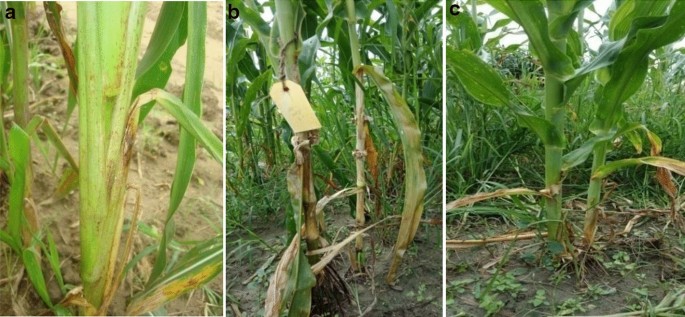Banded leaf and sheath blight(BLBS)
C/O: Anamorph: Rhizoctonia solani f. sp. sasakii
Teleomorph: Corticium sasakii, syn. Thanatephorus cucumeris)
Symptoms:
- infecting the plant in all the growth stages
- Leaves ,sheath and husk of corn showed the characteristics symptoms of concentric bands and rings that are discolored, brown, tan or grey in color.
- blotches are grayish-green, with bluish gray or straw colored centers and with distinct brown borders
- Ear rot can also be observed, light brown , cottony mycelium on the ear is clearly visible.
- At later stage small , round , black sclerotia can also usually observed on the growing mycelium
- The developing ear is completely damaged and dries up prematurely with cracking of the husk leaves. Infected ears may be wholly or partially rotten showing some seed germination
- Can infect leaves, sheath, stalks and cobs.
- At first disease are developed on the first and second leaf sheath above the ground which after development spreads upto ear causing ear rot. According to (Kumari, 2012) three types of ear rot are seen.
- If infection occurs before ear emmergence ear cannot be developed if developed remains rudimentary.
- If infection occurs after ear emmmergence stalk fibre at the tip darkenes, becomes caked-up and turn into hardened lump leading to poor grain filling.
- If infection occurs after grain formation, the kernels becomelight in weight, chaffy and lusterless.

Favorable condition
- The optimum temperature for the disease to occur is 28-30°C
- relative humidity of 90-100%, below 70 percent is not favourable for disease to occur or is negligible
- Disease spreading is highly influenced by high relative humidity and rainfall.
- Rainfall over 100 mm in the first two weeks of infection favours early infection and disease development in plant.
Survive and spread:
- Soil borne disease
- Survive: sclerotia that are present in the soil or that are present in the debris of the host which are infected, and active mycelium growing on the vicinity of maize.
- Spread: Secondary spread of this disease is due to the contact of infected leaves or sheaths with the healthy plants.
Management:
- Fungus: Gliocladium virens, Trichoderma harzianum, T. viride, Neurospora crassa, Aspergillus spp.and Penicillium spp. have been known to inhibit the growth of mycelia, sclerotia formation and germination of solani (Mew & Rosales, 1984).
- The most effective control of the sclerotial state of the disease was with Bavistin 50 WP (carbendazim) giving 87percent of the disease control which was followed by Brestan 60 WP (fentin), Calixin 75 EC (tridemorph),Difolatan 80 WP (captafol) and Benlate 50 WP (benomyl) with 77, 74, 72 and 32 percent disease control, respectively (Sinha, 1992).
- Fungicide: carboxin, TPTH and thiobendazole.
- Systemic fungicides, Orthocide 50WP (captan) 3g/l, Antracol 70 WP (promineb) 4g/l or Dithane M-45 (mancozeb) 2g/l reduced disease intensity up to 32-44 percent.